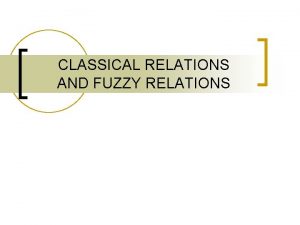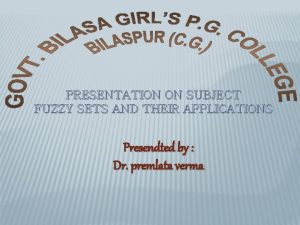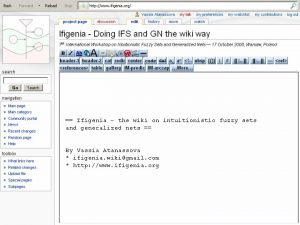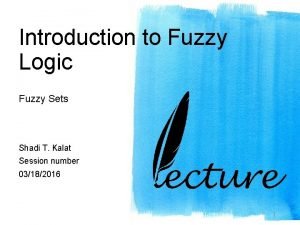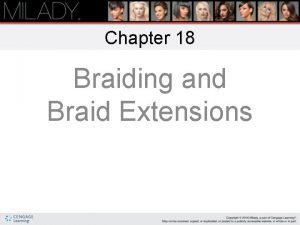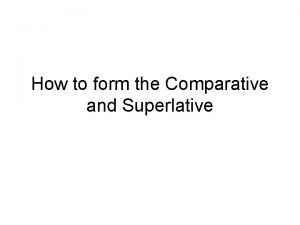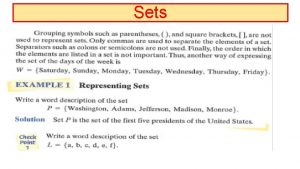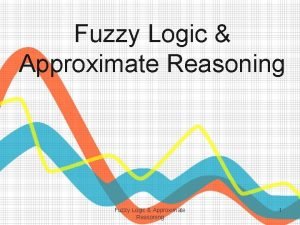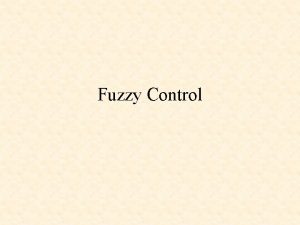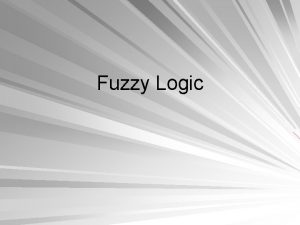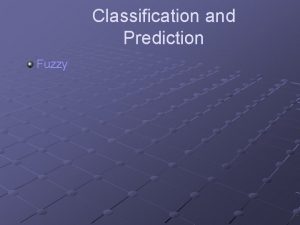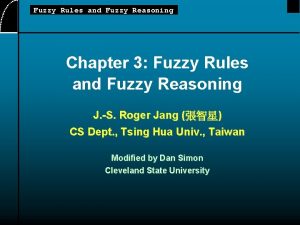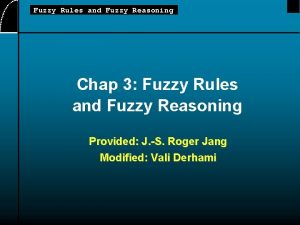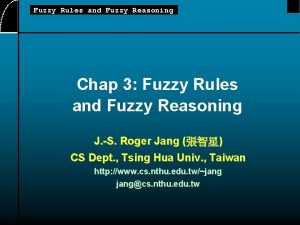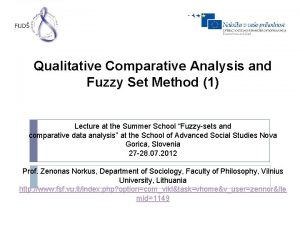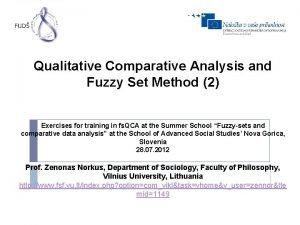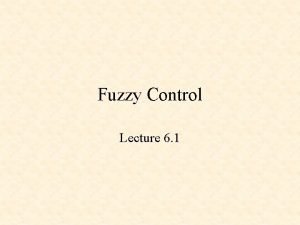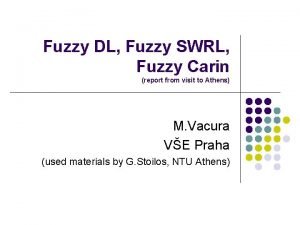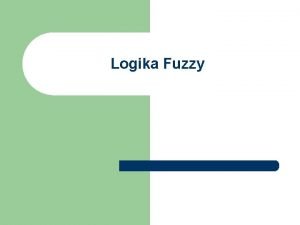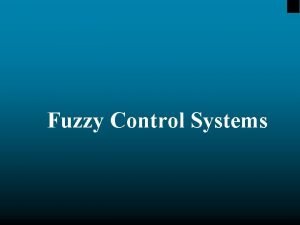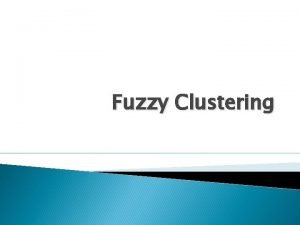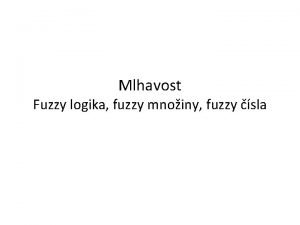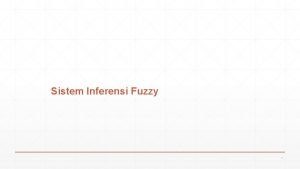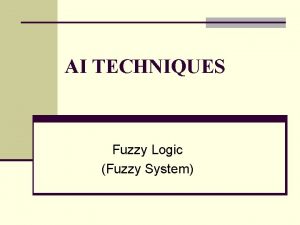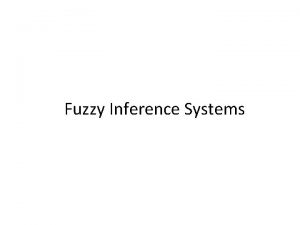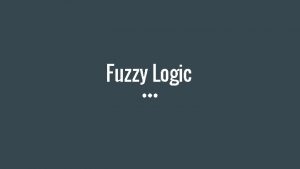Fuzzy Sets and Qualitative Comparative Analysis for Water



































- Slides: 35

Fuzzy Sets and Qualitative Comparative Analysis for Water Researchers This workshop aims to introduce realism and also to present QCA. You can choose from these several strands. Wendy Olsen Spring 2012

Aims for Realism Session Participants are introduced to key terminology and philosophical starting-points of realism. The impact on epistemology is profound, e. g. : – questioning ‘casing’ before making typologies; – raising issues of the purpose/audience of knowledge (and knowledge/power) prior to the validity of knowledge – downplaying measurement metrics The role of retroduction is stressed.

Aims for Research Design & QCA Introductory Session Students will learn what QCA is How it fits into a research project How fuzzy sets differ from crisp sets And a few hints about: • . . . converting data to fuzzy sets in SPSS • . . . creating fuzzy set empirical data in NVIVO

open system • Organic • Permeable • Heterogenous set of structures and systems • Self-aware • For such a system one needs an encompassing social theory 4

• ONTOLOGY ↑ NEW KNOWLEDGE 5

• FRESH ONTOLOGICAL CLAIMS • (e. g. that democratic management can take new forms…) ↑ NEW KNOWLEDGE (this is a realist approach to knowledge) 6

• QCA-SPECIFIC ONTOLOGICAL CLAIMS • E. g. that management of irrigation takes these 3 main forms: » Y 1, Y 2 and Y 3 but that they overlap. One is for the public voting system, one is for the internal management bureaucracy, and one is for the relationship of reservoir&Canal user groups with their members. » Furthermore there is differentaiton of the relations between the parts of this system. It is also an open, reflexive system. » Making a typology is going to be very hard! – FALLIBLE KNOWLEDGE ASKING WHY THIS PARTICULAR TYPOLOGY e. g. Lam & Ostrom ‘use of local collective action systems of norms’ (this is a realist approach to knowledge) 7

realist approach to knowledge makes reference • • Referentiality Essentialism Contingency Incidental conjunctures vs. those which display systematic patterns due to deep essential features of the component parts – not inalienable, - But relevant and we use the ‘modal logic’ to describe them. (Rohwer, Euro. Soc. Rev 2009) SOME/A LOT or ALL or

The modal logic: SOME/A LOT or ALL or NEVER/NONE. • These are not merely descriptive statements. • They rise to a more abstract level. • In realism however the fact that more enduring social structures do exist is taken as a given (DO YOU BELIEVE THIS? ) • Therefore it is well worth describing their interplay and conjunctural causality • This is not deterministic. Nor probabilistic.

BUZZ QUESTION • In realism however the fact that more enduring social structures do exist is taken as a given. • DO YOU BELIEVE THAT STRUCTURES EXIST? • What evidence would you need to become convinced that a traditional structure had begun to break down and be replaced? • E. g. A norm.

Critical Realism • • • Three domains of reality – the ‘real’, actual, and empirical domains. Generative causal mechanisms Open system Retroduction – a method to complement deduction and induction Enduring structures Recognizing overlap of the subjective and objective Rejecting most determinism Interest in Counterfactuals Idea that the choice of methods arise from the topic, ie is ontologically informed. *Contingency, conjunction – these are not specific to realism. In general the emergent properties of things get attention • • CRITICAL ASPECTS OF REALISM Meta-critique occurs when the concepts in a theory are examined political, socially and historically for the role they play in ongoing social politics. Theoretical pluralism results: we have to compare theories, not just work on comparing cases. Explanatory critique is often the result: – Theory A is out of date because it claims to be a perfect description but misses out these ontic aspects; – Theory B is better but ignores its own ideological role; – Our theory, Theory C, is even better…based upon evidence and meta -critique of A and B… 11

Aims for Research Design & QCA Introductory Session Students will learn what QCA is How it fits into a research project How fuzzy sets differ from crisp sets And a few hints about: • . . . converting data to fuzzy sets in SPSS • . . . creating fuzzy set empirical data in NVIVO

General Introduction to QCA Qualitative Comparative Analysis

QCA • Comparative. . . Aims to seek out cases with similarities and differences, and to look into why these exist. • Qualitative. . . Uses qualitative evidence, and based the researchers’ interpretations on detailed local field knowledge. – Field knowledge is linguistically well grounded in local lay discourses – Field knowledge involves primary data

the epistemology of causal analysis with fuzzy sets Warning: these issues are more easily handled by those researchers trained in qualitative methods! Yet the Boolean reduction methods involve mathematical knowledge!

Knowledge is Referential • The fuzzy sets and crisp sets should refer to things in the real world that we can make reference to in sensible ways. • -categorise them as crisp sets if they fall naturally into ‘binaries’ YES/NO, HIGH/LOW – Ragin considers these as set memberships. • --record levels or ranks of them if you can measure the degree of membership in the sets; this gives fuzzy sets.

Basic Ragin-Walters Model

What is Casing? • Casing refers to • However there is also deciding on the nature a stage of of the cases construction of variates for each or some cases. • Labels • Boundaries • Essential characteristics • . . . typology. . . • Labels for features of the cases • Detailed memos • Crisp set values • Fuzzy set values

Model of Education Performance in Northeast UK Schools

Nested Cases Multi-level Cases Nested cases: Schools have Classes have Students.

Transforming Variables • The act of transformation should not make a variable breach its own truthfulness (validity of reference), nor ruin the accuracy of its capacity to represent something. • Moving ‘upward’ to more detail from less is likely to break this rule, unless a rationale is given (e. g. from CRISP to FUZZY). • Moving ‘downward’ from cardinal to fuzzy is more likely to be valid. – but. . (!)

Forbidden combinations of terminology • Inference from sample to population and qualitative or mixed-methods QCA if the QCA does not have a random sample basis • Fuzzy sets and the % of variance explained, or R-squared • Fuzzy set QCA and the goodness of fit of a model • Correlation and fuzzy sets

View some fuzzy sets resistfz hhid class worker workland farmerll assets education 1 0 2 0 1 0 0. 87 0. 17 2 0. 87 2 0 1 0 0. 5 3 1 2 0 1 0 0. 5 1 4 0. 87 2 0 1 0 0. 67 0. 33 5 0 2 0 1 0 0. 33 0. 17 6 0 2 0 1 0. 67 7 1 2 0 1 0 0. 5 0. 87 8 0 2 0 1 0 0. 87 0. 67 9 0. 87 4 0 0 1 0. 87 1 10 0. 87 5 0 0 0 1 1 11 0. 87 2 0 1 0 0. 87 0. 17 12 0. 87 3 0 0 1 1 0. 17 13 0 0 1 1 0. 33 14 0. 87 2 0 1 0 0. 17 0 15 0 0 0 0. 87 0. 67 16 0 1 1 0 0 0. 33 0. 87 17 0. 87 4 0 0 1 0. 87 1 fuzzy ordinal crisp fuzzy TYPE: i. d.

Fuzzy set algebra • OR means the union of two sets. • The ‘union’ in Boolean algebra means ‘take the maximum of the two values’ • X OR Y means ‘does membership in X or Y

Boolean Intersection • AND means the intersection of two sets. • We interpret AND to mean ‘does the configuration of X and Y involve membership in both X and Y? To what extent? ’ • X and Y implies taking the minimum of X, Y

Boolean Notation • OR is often presented as – OR is also presented by + • AND is presented as – AND is also presented by * • NOT is presented by ~ – NOT is also shown by small letters.

Boolean algebra as maths • A function in a spreadsheet is shown with a = preceding it to show Excel that this is not a string. • A string has a ‘ in front of it, in case there is doubt, e. g. ‘ 9 Sept. 2009’ is a string. • =max(b 3, c 3) gives the union • =min(b 3, c 3) gives the intersection

Consistency For Sufficiency • Consistency is a measure of the extent to which membership strength in the causal configuration is consistently equal to or less than membership in the outcome (Epstein et. al, 2007: 10). • The set membership measure is also called the inclusion ratio by Smithson & Verkuilen (Sage volume). They do not claim that an inclusion ratio implies causality.

Definition of a Measure of Sufficiency of Cause (Ragin, Rihoux, & Others) • For each configuration, the joint membership scores (X 1 X 2 Y) are added for all cases. This number is divided by the sum of all minimum membership scores in the causal combination X 1 X 2. The general formula for consistency is: • Consistency (Xi ≤Yi) = Σ(min(Xi, Yi)) / Σ(Xi).

Coverage (for Sufficiency) • On the other hand, coverage refers to the proportion of the sum of the membership scores in an outcome that a particular configuration explains. In other words, it explains how many cases are covered by the sufficiency configuration for outcome Y. • Coverage (Xi ≥ Yi) = Σ(min(Xi, Yi)) / Σ(Yi).

Fuzzy Set Example • Ragin has looked at the Bell Curve of IQ. • Intelligence quotients are usually looked at using ‘parametric statistics’. Studies: – a) desire inference as a kind of generalisation – b) require assumptions about distributions – c) seek a mixture of both necessary and sufficient conditioning of Y on each X. All diversions away from this is considered ‘error’. Cannot presently separate necessary cause from sufficient cause. • Certain configurations cause High IQ scores.

Remember to try out the negation. • Causal analysis of the negation may not be exactly symmetrical to the inverse of the causality of the positive instances. • There are several reasons. – Use of 0. 5 puts a case in >1 configurations. – Use of comparisons of levels like 0. 71 or 0. 83 within small configurations can occur, and we cannot see that this is happening in fuzzy set analysis. When we invert, the study of the negation focuses on different values. – Treatment of remainders. (Deletion) – Setting of the threshold for the fuzzy set intersection of X vector with Y fuzzy set. – Setting of the minimum size of the configuration to count.

Conclusion • We looked at how Cases are compared in QCA. • We set up some crisp and fuzzy set algebra. The same algebra works for both. • Set membership measurement invokes ontological and epistemological issues. – We examined how necessary cause and sufficient cause can perhaps be represented using the Intersection function from the boolean algebra. – We studied an example using fuzzified IQ scores.

ANNEX: Definition – Consistency of Necessary Cause • For each configuration (row in the truth table), minimum membership scores (causal combination intersected with outcome) are added for all cases. This number is divided by the sum of all minimum membership scores in the causal combination. The formula for consistency for necessity is: • Consistency (Xi ≥ Yi) = Σ(min(Xi, Yi)) / Σ(Yi).

Coverage for Necessity • On the other hand, coverage refers to the proportion of the sum of the membership scores in an outcome that a particular configuration explains. • Coverage (Xi ≤Yi) = Σ(min(Xi, Yi)) / Σ(Xi).
 Fuzzy sets and fuzzy logic theory and applications
Fuzzy sets and fuzzy logic theory and applications Water and water and water water
Water and water and water water Fuzzy tolerance relation
Fuzzy tolerance relation Decomposition theorem of fuzzy sets
Decomposition theorem of fuzzy sets Intuitionistic fuzzy sets wikipedia
Intuitionistic fuzzy sets wikipedia Intersection of fuzzy sets
Intersection of fuzzy sets Bounded product fuzzy set
Bounded product fuzzy set Preparing textured hair for braiding
Preparing textured hair for braiding What is quantitative example
What is quantitative example Quantitative data vs qualitative data comparison
Quantitative data vs qualitative data comparison Which of the following is an example of quantitative
Which of the following is an example of quantitative Comparative form.
Comparative form. Iso 22301 utbildning
Iso 22301 utbildning Typiska drag för en novell
Typiska drag för en novell Nationell inriktning för artificiell intelligens
Nationell inriktning för artificiell intelligens Ekologiskt fotavtryck
Ekologiskt fotavtryck Varför kallas perioden 1918-1939 för mellankrigstiden
Varför kallas perioden 1918-1939 för mellankrigstiden En lathund för arbete med kontinuitetshantering
En lathund för arbete med kontinuitetshantering Kassaregister ideell förening
Kassaregister ideell förening Tidbok yrkesförare
Tidbok yrkesförare A gastrica
A gastrica Densitet vatten
Densitet vatten Datorkunskap för nybörjare
Datorkunskap för nybörjare Boverket ka
Boverket ka Hur skriver man en tes
Hur skriver man en tes Delegerande ledarstil
Delegerande ledarstil Nyckelkompetenser för livslångt lärande
Nyckelkompetenser för livslångt lärande Påbyggnader för flakfordon
Påbyggnader för flakfordon Arkimedes princip formel
Arkimedes princip formel Publik sektor
Publik sektor Kyssande vind
Kyssande vind Presentera för publik crossboss
Presentera för publik crossboss Jiddisch
Jiddisch Vem räknas som jude
Vem räknas som jude Treserva lathund
Treserva lathund Mjälthilus
Mjälthilus


